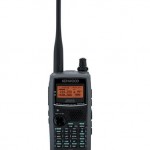
This is the radio I’d like to take along. It’s got everything it needs to do both voice and APRS. |
The whole point of lugging this solar panel along is to have enough power to not need to compromise on my connectivity. I want to be able to blog, to take copious amounts of photographs, to stay in touch with the world, especially my family and friends and have some left over for luxuries like playing Ham Radio along the way.
Since I’ll be traveling alone, the staying in touch will be important. I hope my family will want to know where I am and that I’m safe! I also want to be able to let the people in the cyber-community know how things are going as well.
Ham Radio will also be a part of that. For those of you not familiar with it, you’ll hear a lot about it as I go here. I’ll be using two types of radio communication – almost three, in a way.
I hope to have a VHF/UHF Handheld transceiver along. Think walkie-talkie. This will have two areas of function: local voice communication and APRS data transmission. I want to pick up a radio that will do both in one unit and combine functions.
Local voice communication may be very valuable in getting to know the local people and find local information, maybe even offers of places to camp or stay. I know from experience that a strange voice coming in on the local repeater frequency telling the story of traveling on a bike will get some curious attention, even from Hams.
The Data radio part is also very interesting, both to meet locals, but it will allow anyone, anywhere to track my location and see where I am. Yes, you can do that nowadays with a cell-phone (and I may) but Hams pioneered this technology. APRS stands for Automatic Packet Reporting System and uses short bursts of audio encrypted with data that sounds like your old dial-up modem over the radio. These short bursts contain a fairly small amount of information, think of it like a text message, but they get automatically relayed from point to point. Tie in a GPS and add some other information, it gets passed from station to station and out to the internet and voi-la, I pop up on a map!

The K2 is a radio I already have. It’s a great QRP radio and I always enjoy using it. |
The other half of the Ham Radio operating will be HF or Short-wave operation. This is my real love and I’ll be doing it with what we call QRP, or low-power. I don’t intend on doing this while in motion, although there are hardy Hams who do from a bicycle. The size of an efficient antenna is just out of the question for serious operation in my mind. I’ll save it for the evenings, sitting by the camp or in my tent. Antennas will be wires strung into conveniently existing trees.
What do I mean by QRP? How low is low? Well, it’s typically 5 watts or less, can be either voice or Morse Code and can potentially reach all over the world. It’s kind of at the whim of conditions, but that just adds to it’s charm. You never know who or where you’re going to talk to. It’s also pretty friendly on the battery operation.
The purpose of this – strictly recreation. The VHF radio will probably be of more use in case of an emergency, although you can never rule anything out.

Acer Aspire One. I still like this little laptop. |

The HTC Incredible, providing phone and data. |
Then there’s the data stuff. I’m hoping I’m pretty well set on that front already. My Aspire One netbook is enough to survive on and blog with and will easily do all the photo work I need. I hope to frequently find wi-fi available too, but if not, I can tether it to the Droid and work that way. In a pinch, I can do many of the things I need right from the smartphone as well.
One other thing the Android phone does pretty well is navigation. That saves another device. I have both Google Maps and Bing Maps on it and it’s a toss-up which is better. I’ll probably run a tracking service on it as well and you can all compare the APRS to the Cellular tracking and see if they agree!
Of course, there is always going to be places where I can’t find either wi-fi or data coverage on the cell phone, I’ll just have to tough it out!
Finally, there is the photography. I bought a Canon PowerShot SX-120IS a while back, specifically for carrying on the bike. I have a large digital SLR, the Canon Rebel XTi, and would like to take that, but it might just be too much weight. The PowerShot was a compromise between a pocket-sized convenience camera and one with a decent sized lens and zoom capability. It’s got a lot of other nice features, including pretty decent low-light and high-ISO settings, for those times when you don’t want a flash. Of course, after I bought it, out came many better models, including some mid-sized cameras with interchangeable lenses, but I’m not unhappy with my choice.




